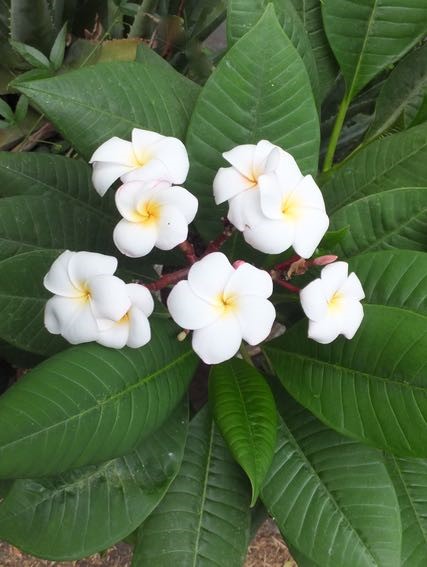
Ideally you need a warm sunny greenhouse for Plumeria to thrive for if you keep these happy they’ll reward you with months of the most delicious blooms each so heavily perfumed you almost want to eat them (please don’t, they’re likely poisonous). Their common name Frangipani was taken from an Italian Renaissance nobleman who blended an almost overpowering perfume of the time to which this exotic tropical flower scent was likened when discovered at the end of the Seventeenth century.
This is a small genus of trees and shrubs in the Periwinkle family. Introduced from Mexico, the West Indies and Central America oddly you are more likely to see P. acutifolia growing, almost in profusion, in the Far East. There they’ve been planted outside both Mohammedan and Buddhist temples and are known as Pagoda trees.
The main stem and branches are fat, finger like and appear succulent, somewhat resembling the trunk of a papaw tree. From the ends of these branches a number of large glossy leaves sprout in neat tufts and then upright bunches of the gorgeous buds and blooms in red and creamy whites. These are heavily scented most especially in the evening and all night and still give off their perfume once picked or fallen.
Native to the Tropics Frangipanis need warmth and moisture and given time and large enough tubs can reach several metres. However they flower from when small and can be pruned to remain even more compact. Happiest in a free draining loamy leaf-mould rich compost these can be grown from seeds, or cuttings (dry off the cut ends before rooting as you would a Pelargonium). However being slow growing these are better bought at flowering size (from about a foot).
Frangipani are thirsty needing plenty of water when in growth and more so in bloom but in the off season need to be kept almost bone dry or you can easily lose them (also just like papaws). In the growing season add liquid feed regularly. If very hot and dry watch out for red spider mite, and at night for snails which may spoil the lovely foliage.
Plumeria acutifolia and the dark red bloomed P. rubra are now the only forms commonly available. However Roy Genders in his Scented Plants of the World found eight, and the Victorian Dictionary of Paxton listed two dozen in cultivation!


